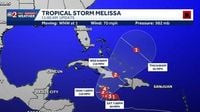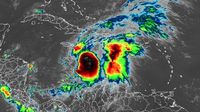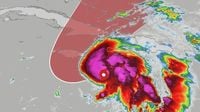For residents of Jamaica and its Caribbean neighbors, the last weekend of October 2025 has brought a mounting sense of dread as Tropical Storm Melissa, the thirteenth named storm of the Atlantic hurricane season, barrels toward the region with a slow but ominous advance. As of Saturday morning, Melissa hovered just 155 to 165 miles southeast of Kingston, Jamaica, packing sustained winds near 70 mph—perilously close to hurricane strength, according to the National Hurricane Center (NHC). Forecasters from multiple outlets, including ABC News, weather.com, CBS Miami, and CNN, warn that Melissa is poised to undergo rapid intensification, potentially becoming a Category 4 or even Category 5 hurricane as it approaches Jamaica and Haiti over the coming days.
Melissa’s slow crawl—moving at just 1 mph—has already spelled trouble for the region. The storm’s outer bands have unleashed soaking rains and gusty winds across Jamaica, Hispaniola, and Puerto Rico, setting the stage for what officials are calling a potentially catastrophic event. The NHC has issued hurricane warnings for Jamaica and hurricane watches for Haiti’s southwestern peninsula, urging residents to prepare for life-threatening conditions. In their Friday evening update, the NHC stated, “Potentially catastrophic flash flooding and landslides are possible across portions of Jamaica and the southern Dominican Republic, while catastrophic flash flooding is anticipated in southern Haiti.”
What makes Melissa especially alarming isn’t just its projected wind speeds—which are expected to exceed 110 mph as the storm approaches Jamaica on Sunday—but its glacial movement. Slow-moving storms are notorious for unleashing extraordinary amounts of rainfall, as they linger over the same areas for days. The NHC has warned that rainfall totals could reach 35 inches in southern Haiti and up to 25 inches in Jamaica through early next week, with locally higher amounts possible in mountainous regions. Such deluges are likely to trigger widespread, life-threatening flash flooding and landslides, particularly in the steep terrain of Haiti, Jamaica, and the Dominican Republic.
Already, the toll is mounting. According to CNN, at least three deaths have been reported in Haiti, two resulting from a landslide, while the Dominican Republic has seen at least one death and the displacement or evacuation of more than 1,000 people. The Haitian Civil Protection Agency has underscored the danger, warning that “extensive damage to roads and buildings is expected, potentially isolating communities for an extended period of time.”
Jamaica, home to nearly 3 million people, appears to be ground zero for Melissa’s wrath. The island has not seen a hurricane of this potential magnitude since Gilbert, a Category 4 storm, struck in 1988. The comparison is sobering: Melissa is expected to approach from the south and linger longer than Gilbert, raising the possibility of even greater devastation. The storm surge threat is also acute, with 7 to 11 feet possible in southern Jamaica, including Kingston harbor, as reported by weather.com. Downed trees, widespread power outages, and structural damage are all but certain if the forecasts hold true.
Jamaican officials are not taking any chances. All public hospitals have been placed in “emergency mode” since Thursday evening, suspending outpatient and elective procedures to free up beds for potential casualties, according to Jamaica’s Minister of Health and Wellness, Christopher Tufton. Airports remain open for now but are expected to close within 24 hours of a hurricane warning being issued, per Daryl Vaz, Minister of Science, Energy, Telecommunications and Transport. Prime Minister Andrew Holness, in a Friday press conference, urged citizens to act: “You have been given enough notice that [Melissa] is coming and that it could be disastrous, so take all measures to protect yourself.”
Haiti, meanwhile, faces its own dire set of challenges. The storm’s slow approach means relentless rain over already saturated ground, increasing the likelihood of catastrophic landslides and flash floods. The NHC has warned that “this is a life-threatening situation and immediate preparations to protect life and property should be taken.” In the Dominican Republic, authorities are bracing for similar impacts, with heavy rains and flooding already displacing thousands.
After its anticipated assault on Jamaica and Haiti, Melissa is forecast to move northward, crossing southern Cuba and reaching the central or southern Bahamas by Wednesday or Thursday. Eastern Cuba could see up to 15 inches of rain, while southeastern Cuba is expected to receive up to 12 inches. The Bahamas, Turks and Caicos, and even parts of the U.S. East Coast may experience hazardous sea conditions, rip currents, and rough surf as Melissa pushes further into the Atlantic, though direct impacts to the mainland U.S. are not expected at this time, according to CBS Miami.
Melissa’s explosive strengthening is part of a troubling trend. As CNN notes, three of the four Atlantic hurricanes this season—Erin, Gabrielle, and Humberto—have undergone extreme rapid intensification, a phenomenon that scientists link to warming ocean waters fueled by climate change. The Caribbean Sea’s deep, exceptionally warm waters have provided ample energy for Melissa to intensify, with wind shear expected to decrease further over the weekend, removing a key obstacle to the storm’s growth.
For now, uncertainty remains about Melissa’s exact track and intensity. Forecast models have diverged, with some showing a more southerly track near Jamaica and others projecting a path toward Cuba and the Bahamas. The NEXT Weather Team at CBS Miami reports “low confidence in the forecast track,” noting that “the team is seeing more of a circle instead of a forecast ‘cone’ for now.” Still, the consensus is clear: Jamaica and Haiti are in for a multi-day onslaught of heavy rain, destructive winds, and dangerous storm surge.
As the region braces for Melissa’s impact, memories of past storms linger. Hurricane Beryl in July 2024 was the last significant storm to affect Jamaica, skirting the island with flooding rains and strong winds as a Category 4. But unlike Beryl, Melissa is expected to make a more direct and prolonged hit, potentially rewriting the record books for the strongest hurricane to strike Jamaica since reliable recordkeeping began.
With so much at stake, the message from meteorologists and officials alike is unambiguous: take Melissa seriously, heed all warnings, and make every possible preparation. The coming days will test the resilience of Jamaica, Haiti, and their neighbors as they face what could become one of the most destructive hurricanes in recent memory.


